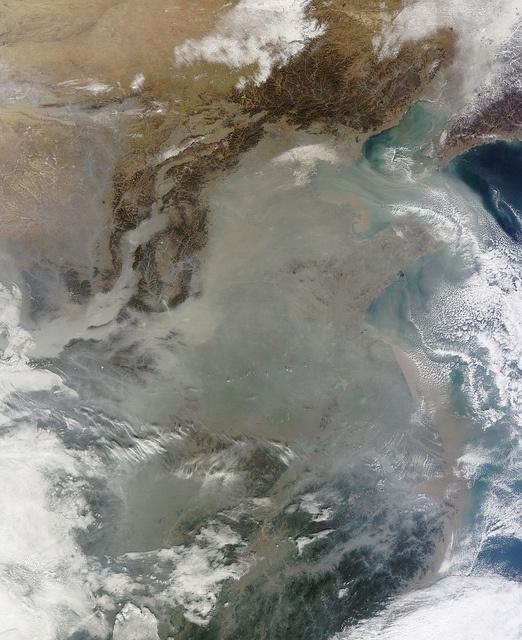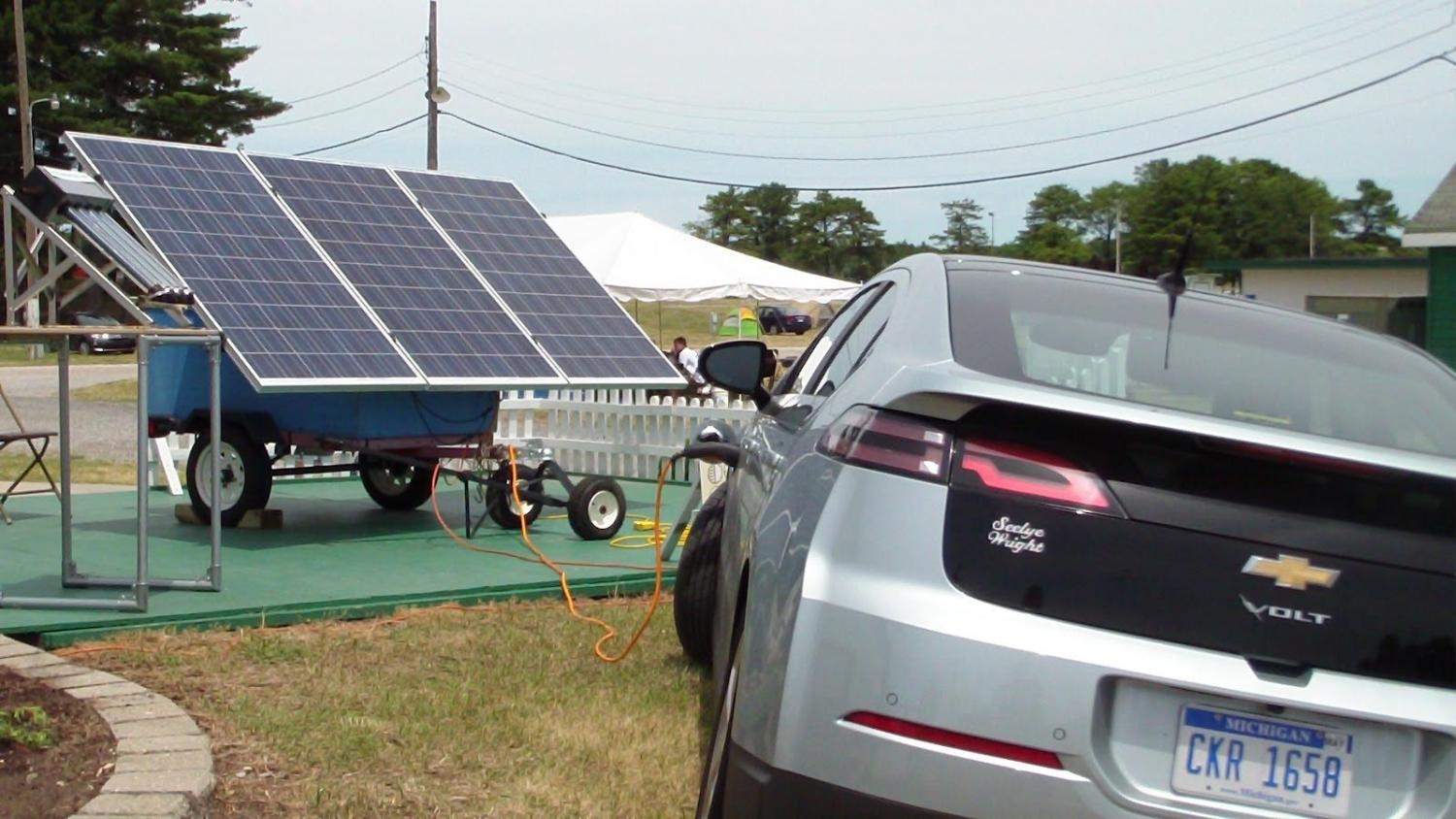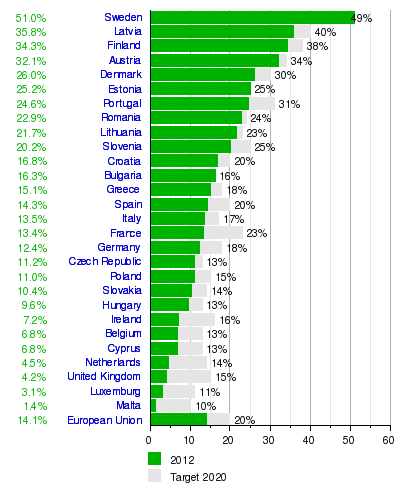New Study Reveals the Workings of China's Pilot Emissions Cap-and-Trade Systems


Environmental and ecosystems degradation – air pollution in particular, most recently – has become a hot-button issue for the Chinese government and society. With increasingly polluted lakes, rivers and coastal waters, desertification and land degradation, and toxic air, perhaps nowhere in the world are the profund and far-reaching costs of an unconstrained, unregulated quest for rapid economic growth better illustrated.
Responding to rising public alarm and protest, China's government earlier this month pledged to tackle its pollution an environmental problems. Declaring a “war on pollution” in his first speech in office to open this year's session of the National People's Congress, Chinese Premier Li Kequiang stated, “Smog is affecting larger parts of China and environmental pollution has become a major problem, which is nature’s red-light warning against the model of inefficient and blind development.”
Pioneered by the European Union (EU), the Chinese government is turning to emissions cap-and-trade systems as a foundational element in its war on pollution. With pilot markets now up and running in seven major Chinese cities and provinces, Beijing-based consulting firm Environomist and contributing organizations recently released the first comprehensive study of China's nascent emissions cap-and-trade systems.
Ongoing urbanization in China
Urbanization in China has been taking place at an unprecedented rate, fueled by government policies and business investment. Six Chinese cities had populations of more than 10 million and 10 had populations between 5 million and 10 million. The number of urban residents exceeded that of rural areas for the first time in 2011, Bloomberg Businessweek highlights in a recent report.
Along with announcing a “war on pollution,” Chinese Premier Li Keqiang in his first speech in office also established urbanization as a national priority -- an announcement that assures China's cities will continue to expand, both in terms of population and their collective impact on China's ecosystems, environment and natural resources.
According to the government's “National New-type Urbanization Plan (2014-2020)," 60 percent of Chinese will be living in cities by 2020, up from 53.7 percent today.
China's "war on pollution"
China's State Council in June 2013 unveiled a package of 10 anti-pollution measures intended to reduce carbon and greenhouse gas emissions. At the top of the list is a pledge to cut pollution “from six smog-producing industries at least 30 percent per unit of output by 2017,” China's state-controlled Xinhua news agency reported.
New regulations seek to reduce polluting emissions across economic sectors that account for over 70 percent of national emissions, including the thermal electric power, iron and steel, petrochemicals, cement, non-ferrous metals, and chemicals sectors. The aim is to bring them into compliance with international standards established in 47 Chinese cities.
Looking to put more bite into these initiatives, the Chinese government is placing greater emphasis and more resources on requiring more in the way of measuring and monitoring emissions, business disclosure and enforcement. Focused and dependent on spurring economic development and growth, enforcement at the provincial and local levels, in particular, "has long been lax and superficial in China,” Xinhua has pointed out.
Emissions trading: Seven pilot systems
The Chinese government is also betting on emissions cap-and-trade systems as an effective means of curbing pollution and improving environmental health and integrity, particularly in China's burgeoning cities. Pilot emissions cap-and-trade systems are now operating in seven major cities and provinces: Beijing, Chonqing, Guandong, Hubei, Shanghai, Shenzen and Tianjin.
Scientists have long counseled policymakers to take steps to drastically reduce carbon and greenhouse gas emissions, deeming such measures the most effective means of improving air quality. Additionally, scientists argue, such measures maintain the health and integrity of environmental processes and ecosystems upon which society ultimately depends, as well as mitigate the costs and threats posed by climate change.
Employing market-based mechanisms such as emissions cap-and-trade markets as a means of incorporating market externalities and factoring unaccounted-for environmental and social impacts into market prices has become fashionable among the international development community and economists.
Though reviews and analysis of the performance and results of the EU's Emissions Trading System (ETS), the first such initiative in the world, have been decidedly mixed, the ETS, and other such market-based mechanisms launched around the world since, are viewed as an initial step in an evolutionary process -- one that can be effective.
Drawing on contributions from Centre Testing International Corp., China Carbon Forum, the Shanghai Environmental and Energy Exchange, South Pole Carbon Asset Management and the United Nations Development Programme (UNDP), the Environomist's, “China Carbon Market Research Report 2014,” offers detailed insight and analyis of the workings of China's nascent emissions cap-and-trade system, as well as a comparison with the EU's ETS.
The comprehensive and groundbreaking report should prove a valuable information resource to policymakers, businesspeople, scientists and NGOs, as well as anyone concerned about and interested in efforts to curb ongoing increases in carbon and greenhouse gas emissions -- whether in China or elsewhere in the world.
Image credit: Flickr/NASA Goddard Space Flight Center
House Vote on National Parks Could Make or Break Local 'Gateway' Communities


The House of Representatives will vote this week on a bill that would require public participation before a president designates a national park. The proposed bill, H.R. 1459, strips presidents of the power given to them under the American Antiques Act of 1906 to designate a national park.
Specifically, the bill seeks to classify national park declarations under the Antiquities Act as a major federal action and would would require the National Environmental Policy Act (NEPA) to be applied. To meet NEPA requirements, federal agencies must prepare a detailed statement called an environmental impact statement (EIS).
The bill would also limit national park declarations to one per state during a president’s four-year term in office, unless otherwise approved by Congress.
The bill is sponsored by Rep. Rob Bishop (R-UT) who criticized President Barack Obama’s use of the Antiquities Act earlier this month to expand the Coastal California National Monument to include the Point Arena-Stornetta Public Lands. Bishop characterized Obama’s use of the Antiquities Act as “disappointing to say the least.” He added that it “is also purely political and undermines sincere efforts to reach consensus on questions of conservation.” Bishop described H.R. 1459 as being “about transparency and fairness.”
Bishop claimed that Obama going around the Congress to include the Point Arena-Stornetta Public Lands in the Coastal California monument “only hurts our country as we move forward tackling some of the biggest issues facing the American people.” A recent report about the economic value of the National Park Service shows otherwise. In 2012, national parks brought $1.5 billion in economic benefits. National parks had more than 282 million visitors in 2012, an increase of 3.9 million over 2011, and those visitors spent $14.7 million in local gateway communities. The money spent by the visitors to national parks contributed 243,000 jobs and $9.3 billion in labor income, according to the report.
A look at some specific instances of how national parks brought money and jobs to gateway communities shows just how valuable they are to the overall economy. Take the three Flagstaff, Ariz. area national parks (Sunset Crater Volcano, Walnut Canyon and Wupatki). There were 489,906 visitors to the three parks who spent $26,362,000 in gateway communities which supported 337 jobs in those communities. Or take the Fire Island National Seashore in the state of New York which had 483,334 visitors in 2012. Those visitors spent more than $19 million in gateway communities which supported 206 jobs.
The 16-day government shutdown in October drastically affected NPS visitation and spending in gateway communities, according to another report. All 401 national parks were closed during the shutdown. That resulted in a 7.88 million decrease, a 33.3 percent decline, in overall October visitation -- which caused in a loss of $414 million to gateway communities. A handful of national parks were able to open with state funding before the shutdown ended. For every dollar of funding for those 14 national parks opened with state funding, about $10 was generated in visitor spending.
“National parks are the best idea we ever had,” declared Wallace Stegner, the writer and environmentalist, in 1983. They certainly are a good idea for gateway communities who benefit from the tourism and jobs created.
Image credit: Chris M. Morris
Sustainability reporting moves up British business agenda


While 70% of British businesses identify sustainability as a key driver for growth, only 51% believe that sustainability issues will impact their firm’s financial performance over the next two years, finds a new report.
However, businesses that have made the connection between sustainability and business performance are willing to invest in internal teams to manage and deliver sustainability with81% of the respondents saying that they have more than five staff members dedicated to sustainability at a programme management level.
The report by sustainability analysts Verdantix was commissioned by the BSI, the business standards company, to discover how the challenge of sustainable development is really being addressed by businesses.
David Fatscher, head of market development for sustainability at BSI commented: “Although the results show broad acceptance amongst organizations that sustainability is a relevant issue, British industry still has plenty more to do before sustainability becomes business as usual. But we are encouraged that reporting performance on sustainability metrics such as energy, carbon and social responsibility, is moving up the agenda.”
Indeed, sustainability performance reporting is now common practice for large UK firms and 100% of those surveyed plan to publish a sustainability report in 2014, with 91% integrating financial and sustainability data into their annual report. The most commonly reported sustainability data will be carbon emissions (99%), energy (98%), and social responsibility (93%). A large majority will report on waste (77%), water (77%) and other greenhouse emissions (77%).
Picture credit: © Andrey Burmakin | Dreamstime.com
Why 500 Everyday Americans Are Test-Driving Life Without Clean Water


It’s World Water Day, a time to celebrate global efforts to bring clean water to the 800 million people who still don’t have it. But if all of this talk about the water crisis seems distant or vague, here’s a statistic that should hit closer to home: This year, a majority of the world’s population will live within 31 miles of an endangered water source.
Americans are notoriously oblivious to water issues. A recent study in the journal Proceedings of the National Academy of Sciences found that the average American uses more than double the water he or she estimates, and that most of us are unsure of which practices or appliances consume the most. Americans use more than 450 liters (118 gallons) of water at home every day, more than any other group.
Our cluelessness – coupled with growing scarcity and the specter of climate change – raises an interesting question: How do we change the way we use water before places like Southern California start looking more like South Sudan?
The answer from Los Angeles-based nonprofit DIGDEEP Water: Start by changing the way Americans think about water, then change the way they use it.
Last year, DIGDEEP challenged Americans to reduce their water consumption from 450 liters a day to just four, using the equivalent of four soda bottles to cook, clean, drink and bathe for several days. They hoped a brief run-in with water poverty would change the way participants understand their water while raising funds for water projects around the world. They called their experiment the 4Liter Challenge.
https://www.youtube.com/watch?v=AU1q5X3juU0
“Living on just four liters of water isn’t easy, but many of the participants had a great time with it,” said George McGraw, executive director of DIGDEEP. “People shared really intimate moments: difficulties shaving their legs or washing their hair, inventive ways of cooking a meal or washing the dishes, really moving personal reflections. It’s amazing how the experience sticks with you, even after it’s over.”
The 2013 Challenge, which took place last October, brought together 592 people from six countries and created a social media firestorm. Participants included students, families, working urbanites, and teams from universities, nonprofits and companies. People shared hundreds of photos, videos and tweets from their challenges.
In one of my favorite posts (right), participant Kirsty Spraggon licked her breakfast bowl clean instead of washing it in the sink, sparing a precious few milliliters.
By the end of the weeklong campaign, participants had raised more than $17,000, funding six water projects in South Sudan, Cameroon and the United States (New Mexico). Their experiments with water poverty directly benefitted communities trying to escape that same fate.
This morning, DIGDEEP released an interactive infographic of the best posts from last year’s challenge. The site features “moments” organized by category (like cooking, bathing, cleaning) from real participants, including celebrities like David Henrie, Drake Bell and James Scott. They also built a nifty tool that allows donors to “track” how and where their gifts are being used. The tool was designed by VeryNice.co, an LA-based creative agency and pioneers or the “give-half” model I wrote about here.
While per capita water use in the U.S. has declined in recent years, we’re not out of the woods just yet. Our decisions today – as communities and as individuals – will determine just how much water (and of what quality) we’ll enjoy in the future. Organizations like DIGDEEP believe the critical first step is to change the way we think about water. After exploring the 4Liter Challenge, I’m inclined to agree.
The 4Liter Challenge is an annual campaign by LA-based human rights non-profit DIGDEEP Water. The program includes a social media campaign and a 6-12 grade curriculum, both of which launch every October. You can learn more and join me in pre-registering for the 2014 Challenge by using the link here.
Co-authored by George McGraw.
Jasmine Youssefzadeh is a social entrepreneur committed to finding innovative mediums for non-profits and corporates to build alliances through new media. She is Founder and Director of Production of filmanthropos, a creative agency that specializes in multi-platform storytelling for philanthropies, causes, and corporate social responsibility initiatives.
George McGraw wants to change the way you think about water. George runs the DIGDEEP Right to Water Project in Los Angeles, which he founded. He holds a B.A. from Loyola University Chicago and a professional degree in International Law from the United Nations University for Peace (UPEACE) in San José, Costa Rica. He has worked for several foreign governments and has consulted for the United Nations Development Programme in Afghanistan. His organization DIGDEEP brings sustainable, clean water to communities around the world, while helping Americans to use their own resources more intelligently. George speaks, writes articles and makes all kinds of media for outlets like law reviews, universities, TEDx, and the Huffington Post.
Featured image: Flickr/joeshlabotnik
3p Weekend: 8 New Electric Vehicles and Plug-Ins We Can't Wait to Drive


With a busy week behind you and the weekend within reach, there’s no shame in taking things a bit easy on Friday afternoon. With this in mind, every Friday TriplePundit will give you a fun, easy read on a topic you care about. So, take a break from those endless email threads, and spend five minutes catching up on the latest trends in sustainability and business.
Electric vehicles and plug-in hybrids are inching closer to the mainstream. U.S. plug-in electric and hybrid vehicle sales nearly doubled in 2013, and EV production worldwide is projected to increase by 67 percent this year. Almost all automakers have at least one electric vehicle in their portfolios, and some truly drool-worthy rides are set to hit the market in 2014. Everyone has their favorites, but here are eight new EVs and plug-ins that we can't wait to drive.
1. BMW i8
The highly anticipated BMW i8 plug-in hybrid electric car is entering production in April, with customer deliveries beginning in June. Its electric-only range is decent at 23 miles, but it gets 112 mg and can go from 0 to 62 mph in 4.4 seconds. It's set to hit the European market first and is reportedly already sold out, but we can dream, can't we?
2. Toyota i-Road
The ingenious Toyota i-Road program combines the convenience of a bike rental service, the comfort of an enclosed car and the compact footprint of a motorcycle in an electric three-wheeler. Commuters in Aichi, Japan are already testing the vehicles in self-service sharing stations, and Toyota recently announced it will deploy 70 additional vehicles for a three-year test in in the town of Grenoble, in the French Alps.
The i-Road automatically leans around corners, and Toyota says no specialized skill is required to operate it -- which leads to the second reason we're so excited about this clever little car: It holds vast potential as a form of "last-mile" transport. Potentially, i-Roads could serve as a form of transport that carries commuters from train stations and other public transport hubs to their office complexes -- freeing up dense urban grids and maybe even solving the "Google bus" problem.
3. Tesla Model X
The Tesla Model X crossover offers an all-electric alternative to standard three-row minivans and SUVs. With an 85 kWh battery option that equates to more than 250 miles in range, the Model X can go farther than any other vehicle on our list, and it has some pretty sweet falcon doors to boot.
With the Model X expected to ship by the end of this year and the mass-market Model E in the works, Tesla is showing no signs of slowing down. Its planned battery "Gigafactory" will support the manufacture of 500,000 electric cars per year and will also produce batteries for energy storage.
4. Volkswagen XL1
Volkswagen only plans to make 250 of these hand-built, plug-in-diesel vehicles as test units, but the XL1 made our list because of its sleek and smart engineering. The super aerodynamic plug-in gets its name from the fact that it uses less than one liter of fuel to go 100 kilometers (equivalent to 235 mpg). It's also up for World Green Car of the Year.
5. BMW i3
While not as sexy or sporty as its high-end cousin, the i8, the BMW i3 offers solid range at a reasonable price -- meaning it may fair well in the mass market. At around $40,000, the i3 can travel up to 100 miles on a single charge and can go from 0 to 60 mph in 7 seconds.
6. Kia Soul EV
Those who are sold on the boxy car trend are sure to love the forthcoming Kia Soul EV. Set to hit the market late this year, the Soul offers long range for a low price. It is expected to travel 120 miles on a single charge at a reported price of only $35,000. Count us in!
7. Volkswagen E-Golf
The standard Volkswagen Golf is one of the most popular small cars in the world, and the E-Golf looks strikingly similar -- except with respect to miles per gallon, of course. The E-Golf is expected to travel 90 miles on a single charge and is Volkswagen's first electric car to hit the mass market.
8. Cadillac ELR
We're more or less excited to drive this one to see how it compares with the Chevy Volt. A great deal of its internal specs are similar (a 1.4-liter gasoline engine and 16.5-kWh lithium-ion battery pack), but the ELR boasts a sleek and angular body that's characteristic of Cadillac. Naturally, it has a bit of extra torque, too. We're not sure it's worth it for the 35-mile range and $75,000 price tag, but it's nice to see General Motors expanding its EV offerings into the luxury market.
Speaking of EVs: Triple Pundit hosted a live panel discussion yesterday on the fate of sustainability in the auto market. If you missed the chat, featuring Mike Tinskey of Ford Motor Co., Deb Frodl of General Electric’s Ecomagination and Haukur (Hawk) Asgeirsson of DTE Energy Co., catch it here or on our YouTube channel.
i8 image courtesy of BMW Group
i-Road image courtesy of Toyota
Cadillac ELR image courtesy of Cadillac
Based in Philadelphia, Mary Mazzoni is an editor at TriplePundit. She is also a freelance journalist who frequently writes about sustainability, corporate social responsibility and clean tech. Her work has appeared on the Huffington Post, Sustainable Brands, Earth911 and The Daily Meal. You can follow her on Twitter @mary_mazzoni.
Employee Engagement: Thinking of Changing Vendors? Think Again


Submitted by Guest Contributor
By Matthew Nelson, NYLife
Don't get me wrong, if you are thinking of changing vendors for your employee engagement programs, go for it. But don't go into the process thinking it is going to be easy to flip the switch from one vendor to another.
Here are some lessons I learned to achieve flipping the switch successfully:
The RFP Process: Managing Expectations
When we started the Request for Proposal process, I underestimated the number of partners, the amount of time and the number of communications (managing expectations) needed for a smooth transition. Think about it. Any online system means that you will need to engage the following departments in your company:
- Project management (we are philanthropists and engagement folks, let the experts manage the process)
- Technology (you will get into the weeds like never before)
- Security (you are sending personnel data over the wires, do it safely)
- Audit (they will give you peace of mind, even if it is an arduous process)
- Human Resources (they have the data you need)
- Payroll (especially if you are doing payroll deductions)
- Controllers (they will make you jump through the hoops but it is worth it to know the systems you create internally and with your vendor are rock solid)
You will have lots of new friends from  across the company!
across the company!
Because you are the business owner, you will meet with all of the above departments so they understand your programs. They will want you in every meeting. The transition will be nearly a full-time job for you so make sure your usual job gets covered.
Ultimately, however, your job will be to manage expectations and communicate. Jill Johnson, president of Management Mastery, offers sage advice:
“The project management associated with the evaluation, selection and implementation of a new vendor solution has everything to do with managing expectations and providing frequent, clear and consistent communication. In my engagements, one must constantly re-visit and re-adjust expectations with a variety of stakeholders relative to a variety of topics – budget, schedule, requirements, deliverables, understanding, etc. There is little room for ambiguity in any and all communication – be specific.”
There will be setbacks, unanticipated consequences and glitches. Name that up front.
Expect Crises…
When I bought my first house, a friend and real estate lawyer told me to expect three major crises in the process. When the sewer line looked like it was filled with tree roots, I thought, “one down and two to go.” Normally I would have freaked out, but my expectations were managed well and I was soon the proud owner of my first home.
…And Lots of Communication
You will need to communicate up and out. Your leadership will want to know the progress. Have a small steering committee that can help you get the resources you need to be successful. You might want to have the heads of the departments listed above on the steering committee. Together, they will think of things no one business area would think about.
You will also need to keep your employee base informed. Send out teasers of some of the new upcoming features. If you set a launch date (and give yourself plenty of extra time), make sure you deliver on it. Deadlines are always helpful but they are also fraught with disappointment and the need to  apologize. Lead with your strengths and set a realistic launch date.
apologize. Lead with your strengths and set a realistic launch date.
Pick Up the Slack: Thanking the Troops
After your programs launch, have a recognition event for all those other departments who chipped in. We gave out awards to every person involved. They were all a little silly, but the one-liner awards reflected the role they played in the success of the transition. From the very top, the “Resources R Us” award went to our Chief Administrative Officer for getting all the right people to drive the planning and implementation.
And to all my colleagues who had to jump in and cover my usual work, they received the “Pick Up the Slack” award. The awards were a great way to acknowledge and thank everyone involved.
Making the transition from one vendor to another will give you a whole new skill set, a new set of internal friends, a greater appreciation of how your systems work and the satisfaction of knowing you are promoting philanthropy and engagement in new ways. Buckle up!
Join Matthew at the Charities@Work 13th Annual Best Practices Summit on Employee Engagement in Corporate Citizenship on April 3-4, 2014, one of the country’s leading conferences on employee engagement and corporate social responsibility with attendees from Fortune 500 companies across all sectors of business.
A World Water Day-Themed Google Chat w/ Michael Kobori, VP of Sustainability, Levi Strauss & Co.


Every Week, TriplePundit takes 30 minutes or so to chat with an interesting leader in the sustainable business movement. These chats are broadcast on our Google+ channel and embedded via YouTube right here on 3p.
On Friday, March 21st at Noon Pacific / 3:00pm EST, TriplePundit’s Founder and Publisher, Nick Aster, spoke with Michael Kobori, Vice President of Sustainability at Levi Strauss & Co.
This special chat coincided with the week of World Water Day, and the overarching theme focused on the role of resource conservation in sustainable fashion. Michael provided an overview of Levi Strauss & Co.’s lifecycle assessment strategy (including why the jean manufacturer is focusing on water), product innovations like Water<Less, the company’s involvement with Better Cotton, how LS&Co. is changing processes (including recycled water efforts in the finishing process), and the importance of changing consumer habits.
If you missed the conversation, you can watch it right here or on our YouTube channel.
About Michael Kobori
Michael is the Vice President of Sustainability at Levi Strauss & Co. Under his tenure, the company has been a pioneer, reducing the environmental impact of its products through its Levi’s® Waste<Less™ and Water<Less™ products, Dockers® WellThread Collection, Care for Our Planet program, and leadership on the Better Cotton Initiative. Based on its sustainability work, Levi Strauss & Co. was recently named 30th most innovative company in the world by FastCompany magazine. You can follow him on Twitter: @KoboriGrillsCSR
UN Report Highlights Risks (And Rewards) At The Water-Energy Nexus


The United Nations (U.N.) shines a light on the critical issue of freshwater resources – and linkages with energy – with the March 21 release of the 2014 World Water Development Report (WWDR). Produced by the U.N.'s World Water Assessment Program (U.N.-Water), WWDR 2014 is being released in conjunction with special events sponsored around the world as part of this year's World Water Day celebrations on Saturday.
Forecasting that the global population will need 40 percent more water by 2030, the ambitious report highlights the threat to water supplies posed by the conflicting interests of a growing global population for energy and food, as well as water itself. The list is extensive, including regulations and governance that lead to perverse outcomes, along with threats from water contamination, pollution, climate change and the often profligate ways in which we use and manage freshwater resources.
WWDR 2014 also offers potential solutions, focusing in particular on governance at the water-energy nexus. "Energy and water are at the top of the global development agenda," Rector of United Nations University David Malone, this year's coordinator of World Water Day on behalf of U.N.-Water together with the United Nations Industrial Development Organization (UNIDO), said in a press release.
WWDR 2014's overarching messages:
- Water requires energy, and energy requires water.
- Supplies are limited, and demand is increasing.
- Saving energy is saving water; saving water is saving energy.
- The "bottom billion" urgently need access to both water and sanitation services, as well as electricity.
- Improving water and energy efficiency in all sectors is imperative, as are coordinated, coherent and concerted policies.
- Significant policy gaps exist in this nexus at present, and the U.N. plays an instrumental role in providing evidence and policy-relevant guidance.
As UNU Rector Malone continued:
“Through this day, we seek to inform decision-makers, stakeholders and practitioners about the interlinkages, potential synergies and trade-offs, and highlight the need for appropriate responses and regulatory frameworks that account for both water and energy priorities. From UNU's perspective, it is essential that we stimulate more debate and interactive dialogue around possible solutions to our energy and water challenges."
UNIDO Director-General Li Yong emphasized the importance of water and energy for inclusive, sustainable development.
"There is a strong call today for integrating the economic dimension, and the role of industry and manufacturing in particular, into the global post-2015 development priorities,” Director-General Li noted.“Experience shows that environmentally sound interventions in manufacturing industries can be highly effective and can significantly reduce environmental degradation. I am convinced that inclusive and sustainable industrial development will be a key driver for the successful integration of the economic, social and environmental dimensions."
Facts about the water-energy nexus:
- Ninety percent of power production is water intensive
The International Energy Agency estimated global water withdrawals for energy production in 2010 at 583 billion cubic meters (representing some 15 percent of the world's total withdrawals, or roughly 75 percent of industrial water withdrawals), of which 66 billion cubic meters was consumed.
By 2035, withdrawals could increase by 20 percent and consumption by 85 percent -- driven via a shift towards higher efficiency power plants with more advanced cooling systems (that reduce water withdrawals but increase consumption) and increased production of biofuel. Local and regional impacts of biofuels could be substantial, as their production is among the most water intensive types of fuel production.
- There is an increasing risk of conflict between power generation, other water users and environmental considerations.
Thermal power generation accounts for roughly 80 percent of global electricity production and is responsible for roughly half of all water withdrawals in the United States and in several European countries.
Several factors determine how much cooling water is needed by thermal power plants, including the fuel type, cooling system design and prevailing meteorological conditions. However, efficiency is often the main factor that drives water requirements: The more efficient the power plant, the less heat has to be dissipated, thus less cooling is required.
Hydroelectricity, which can also require abundant water supplies, accounts for about 15 percent of global electricity production.
By 2035, global water withdrawals for energy are expected to increase by 20 percent, whereas water consumption for energy is expected to increase by 85 percent.
Unconventional oil (e.g., oil/tar sands) and gas production (e.g., "fracking") are generally more water intensive than conventional oil and gas production.
Facts about water
- According to the U.N., 780 million people lack access to safe drinking water -- although by some estimates, the number of people whose right to water is not satisfied could be as high as 3.5 billion -- and 2.5 billion are without sanitation.
- Total freshwater withdrawals are believed to have increased by about 1 percent per year since the late 1980s.
- Water demand in terms of water withdrawals is projected to increase by some 44 percent by 2050 due to growing demands from manufacturing, thermal power generation (mainly from the expansion of coal and gas powered plants), agriculture and domestic use.
- The rate of groundwater abstraction is increasing by 1 to 2 percent per year, adding to water stress in several areas. Recent evidence has shown that groundwater supplies are diminishing, with an estimated 20 percent of the world's aquifers being over-exploited, and some massively so.
- Desalinated water involves the use of at least 75.2 TWh per year, which is about 0.4 percent of global electricity consumption.
- It is estimated that more than 80 percent of used water worldwide -- and up to 90 percent in developing countries -- is neither collected nor treated, threatening human and environmental health.
U.N.-Water's 2014 report also incorporates an extensive range of pertinent facts about energy:
- Today, 1.3 billion people live without electricity, and roughly 2.6 billion use solid fuels (mainly biomass) for cooking.
- By 2035, energy demand is projected to grow by more than one-third, and demand for electricity is expected to grow by 70 percent by 2035.
- Modern biofuels represent only 0.8 percent of global final energy consumption, but their contribution to energy supply is expected to grow rapidly. If bioenergy feedstock is produced on irrigated lands, then the potential impact of biofuels on water resources is also of major concern.
- Fossil fuel consumption subsidies totaled $523 billion in 2011 (an increase of almost 30 percent over the total for 2010). Financial support for renewable energy, by comparison, amounted to only $88 billion in 2011, and increased by another 24 percent in 2012.
- With the global energy market estimated at $6 trillion annually, the energy sector is synonymous with "big business." The energy sector is well funded, highly organized, and attracts greatly more political attention than water in most countries.
New EPA Emissions Standard Saves Lives, Creates Jobs


New fuel efficiency and emissions standards are creating stronger automotive jobs in the U.S., as research and development firms wind up to meet the challenges, refineries retool and American manufacturers build new components. That wasn't one of the big headlines from the EPA's announcement earlier this month that it finalized the Tier Three Motor Vehicle Fuel and Emissions Standards. But it's definitely one of the real-world effects.
The new emissions standard takes effect by 2017 and "sets new vehicle emissions standards and lowers the sulfur content of gasoline." The new standard is on top of the fuel efficiency standards set by the Obama administration in 2009, pushing for cleaner more fuel efficient automobiles.
A 2014 report commissioned by the Emissions Control Technology Association shows the Tier Three standard will create of thousands of new jobs operating new refinery equipment and about 24,000 new refinery jobs over three years as refineries retool to meet the new EPA standards for lower sulfur emissions. An earlier Natural Resources Defense Council (NRDC) report from March 2010 showed higher fuel and emissions standards would create 150,000 jobs in the U.S. across a spectrum of job sectors.
The NRDC, in cooperation with the National Wildlife Federation and the Michigan League of Conservation Voters, created a website called DrivingGrowth.org which highlights real-world stories about how raising the bar for cleaner, more efficient cars is in fact a job-creating effort. There are plenty of other resources as well that show how increased fuel standards create real jobs for real people. New emissions rules come along, research and development folks need to find solutions, engineers need to figure out how to make it and integrate it with a car, manufacturers need to produce the part, and shippers need to bring those parts to the assembly line. New standards create a cascade of jobs.
Yeah, the EPA didn't exactly harp on the jobs thing. Mostly they talked about human health and lives saved with the Tier Three standards. Cutting nitrogen oxide and volatile organic compounds by 80 percent, particulate emissions by 70 percent, and gasoline sulfur emissions by 60 percent, Tier Three standards will prevent up to 2,000 premature deaths per year by 2030. It'll also help folks susceptible to respiratory issues breathe easier, preventing 19,000 "asthma exacerbations" and 30,000 upper and lower respiratory symptoms in children. It saves thousands of emergency room visits and millions of days lost to school closings, inability to work and overall reduced activity ability.
And of course, with fewer hospital visits each year Americans will save as much as 19 billion in health care costs each year. We've been paying through the nose with our health and our debit cards to let cars burn toxic, high-particulate fuel.
Perhaps surprising to some, the auto manufacturers were cooperative and supportive of the emissions standards. The only major objections came from oil companies who sang the usual "cost prohibitive" song. They sing that song all the time, though. Maybe what they mean by "cost prohibitive" is that they'll have to hire more people to retool and operate the refineries. And maybe that's not all bad for America.
Image credit: Eric Justian
EU Renewable Electricity Rises Above 23 Percent But Employment, Investment Falters


Renewable energy accounted for 14 percent of gross final energy consumption across the European Union (EU), up from 12.9 percent in 2011, while renewables' share of gross electricity consumption rose from 20.4 percent to 23.4 percent, according to the 2013 edition of EurObservER's “The State of Renewable Energies in Europe.”
Renewable energy employment, economic activity and investment indicators didn't fare as well, however, reflective of ongoing fiscal and economic problems that have caused EU renewable energy leading nations to cut back on subsidies and incentives, or eliminate them completely.
EU renewable energy sector feels the pinch
According to EurObserv'ER's latest report, the number of people employed in the renewable energy sector totaled 1.22 million euros in 2012, down from 1.27 million in 2011. Renewable energy-based economic activity dropped from 141 billion euros to to 130 billion.
EU renewable energy investment indicators – incorporated in EurObserv'ER's report series for the first time – also showed declines. Renewable energy asset finance dropped 39 percent year-over-year to 22 billion euros in 2012 from 36 billion in 2011.
Venture capital and private equity totaled 2.1 billion euros, down 31 percent from 3 billion the year before. Renewable energy stock market indices fell between 35 percent and 63 percent in the 2011-2012 period.
On a positive note, EurObserv'ER estimated EU renewable electricity production at 763.5 terawatt-hours (TWh), a share of 23.4 percent, which seen over a longer term perspective demonstrates just how much can be accomplished in a short amount of time -- given the right mix of governance policies, rules, subsidies and market-based mechanisms.
EurObserv'ER's Barometer report series on renewable energy covers 10 renewable energy sectors (wind, solid biomass, solar PV, biofuels, heat pumps, biogas, solar thermal, small hydropower, waste and geothermal power) individually and in the aggregate across the entire EU.
Pie chart credit: EurObserv'ER
Graph credit: Eurostat